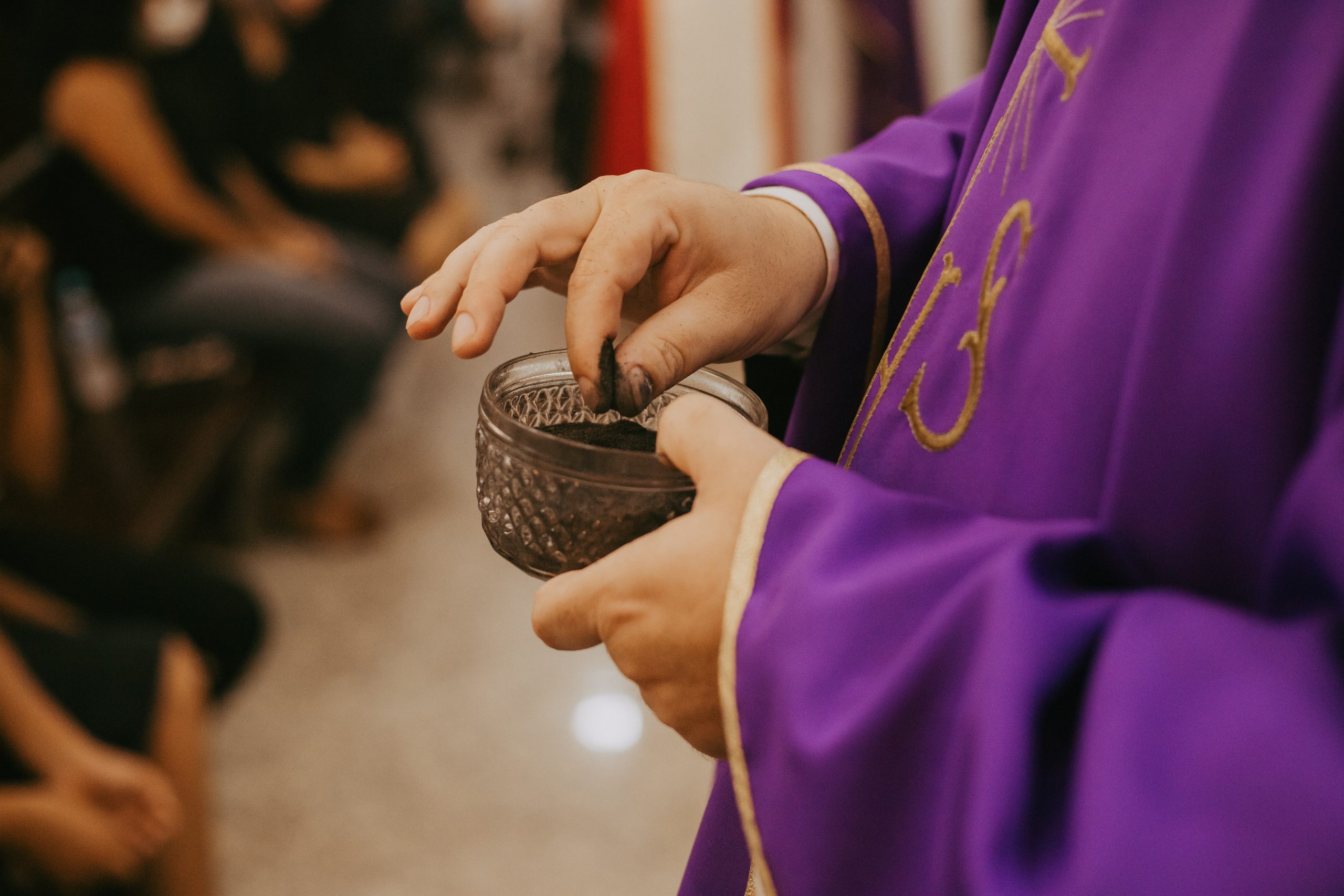What is Ash Wednesday? (+ How To Do It With Kids) - Little Shoots, Deep Roots

As an Amazon Associate I earn from qualifying purchases. This post may contain affiliate links. See my full disclosures, Terms of Use, and privacy policies on my “privacy” page. I never recommend a product I don’t love.
Ash Wednesday was not part of my upbringing, but a few years ago I had a hunch that there was something deeply meaningful about Ash Wednesday, but because it kept sneaking up on me, I never had time to figure it out in time.
You are reading this, now, so I assume you have a hunch that there’s something about Ash Wednesday too. Maybe, just maybe it might help you connect with God in a way that has been dry for a long time.
If you are dissatisfied (mildly or extremely) with cultural Christianity, with the way it angrily denounces the culture while standing on the backs of the bleeding innocent, I invite you to join me on this journey.
If you feel like something’s not quite aligned in your relationship with God and you need a spiritual chiropractic treatment, I invite you to join me.
If you struggle with flippant, easy faith answers or “wash your face” Christianity, this is the time to join me.
Let’s step off the well-worn path of easy answers and pull-up-your-bootstraps-faith and pasted on joy. Together, we’ll get our feet dusty on this ancient but mostly forgotten trail.

The path begins with ashes and dust.
The history of Ash Wednesday
By the sweat of your brow you will eat your food until you return to the ground, since from it you were taken; for dust you are and to dust you will return.
Genesis 3:19, NIV
The path we walk is strewn with ashes from those before us who have lived, mourned, grieved, and repented.
As we travel, clouds of dust hover beside us and in them we see reflections of those who have walked this way before us.
We see Job, repenting in dust and ashes after he lost everything dear to him, except his crotchety wife and judgemental friends.
We pass Jeremiah, pleading with Israel to put on sackcloth and ashes as a sign of her repentance, that she might be forgiven and returned from exile.
We see the city of Nineveh, turning as one repentant soul, clothed in sackcloth and ashes at the feet of the prophet Jonah. (Jonah 3:5–7)
Their memories remind us that sometimes, an outward sign of humility is the very act that brings one to humility.
Why sackcloth and ashes?
“But wait,” you say. “Why are these people wearing sackcloth and covering themselves with ashes?”
The wearing of sackcloth, this vastly uncomfortable garment sewn from itchy goat hair, indicated mourning.
Through motes of dust, we catch a glimpse of Jacob putting on sackcloth to mourn his lost Joseph (Genesis 37:34), and David wearing sackcloth to mourn the death of Abner (2 Samuel 3:31).
Further in, we see the entire nation of Israel, already in exile for disobedience, weeping over yet another impending national disaster. (Esther 4:3)
Sackcloth and ashes were an outward sign of an inward truth.
They signaled to the world that the wearer was in mourning or repentance. At their heart, are they not the same?

What is the significance of Ash Wednesday?
On we walk, until last year’s Palm Sunday. We each snap a branch off a tree and wave it for the incoming king. He rides on a donkey and we shout Hosanna.
But he doesn’t behave like we expect a king to behave, and instead of crowning him with gold we crown him with thorns. We pound nails into his hands and feet and stand at the foot of the cross, mocking. We trample the branches under our feet.

He resurrects, and we pick up the trambled branches with greater wisdom. As we walk through the year, we rejoice in the power of the resurrection.
But we cannot forget that his death was our choice. We are culpable. Though we tried to bring them back by placing their bruised stems in a cup of water, the palms we plucked and waved turn brittle in our hands.
So we have come round again to Ash Wednesday. We light a match to the branches we waved and dropped, and they burn to ash.
Let’s do this next part together. Face me, if you please.
I dip my index finger in the ash. The ash reminds us that we have done wrong, that we have participated in nailing our Savior to his cross. We repent, and I trace a cross on your forehead. You do the same for me, dipping your finger into the ashes of repentance and marking me with a cross…
…a cross made of the ashes of our sin, because our sin turns our world to ash, but Christ turns our sins into ash. He accepts our repentance, this ash-cross we wear.
We remember that we are forgiven.

We didn’t need the ashen cross to be repentant. But it serves as an outward sign of an inward truth: we have sinned, we have mourned our choices and repented, and in the cross of Christ, we are forgiven.
And though we wash off the ash, it remains still, in our memory.
Why do we celebrate Ash Wednesday?
Ash Wednesday is a reminder of our sin in a world where the presence of sin is hotly contested.
We slant our eyes at sin, pretending it doesn’t really exist.
Some say we are only messy or broken. But messy, broken people don’t need to repent. They just need to wash their faces, pick up the pieces, and move on.
This is not what the cross says to us.
The cross says, “you did this.”
But the cross also says, “forgive them, for they know not what they do.”
The cross says, “my God, my God, why have you forsaken me?”
But the cross itself is now forsaken because the cross was not the forsaken end. Life was the end and the beginning.
Sin is sin, but repentance and forgiveness wipe sin clean.
Ash Wednesday is here to remind us that we do need to repent. But Ash Wednesday is also here to remind us that we are forgiven in Christ.
And that is the beginning of all the most beautiful paths.
Verses to read on Ash Wednesday
By the sweat of your brow you will eat your food until you return to the ground, since from it you were taken; for dust you are and to dust you will return.
Genesis 3:19 NIV
“Even now,” declares the Lord,
“return to me with all your heart,
with fasting and weeping and mourning.”
1Rend your heart
and not your garments.
Return to the Lord your God,
for he is gracious and compassionate,
slow to anger and abounding in love,
and he relents from sending calamity.Joel 2:12-13 NIV
1 Have mercy on me, O God,
according to your unfailing love;
according to your great compassion
blot out my transgressions.
2 Wash away all my iniquity
and cleanse me from my sin.
3 For I know my transgressions,
and my sin is always before me.
4 Against you, you only, have I sinned
and done what is evil in your sight;
so you are right in your verdict
and justified when you judge.
5 Surely I was sinful at birth,
sinful from the time my mother conceived me.
6 Yet you desired faithfulness even in the womb;
you taught me wisdom in that secret place.
7 Cleanse me with hyssop, and I will be clean;
wash me, and I will be whiter than snow.
8 Let me hear joy and gladness;
let the bones you have crushed rejoice.
9 Hide your face from my sins
and blot out all my iniquity.
10 Create in me a pure heart, O God,
and renew a steadfast spirit within me.
11 Do not cast me from your presence
or take your Holy Spirit from me.
12 Restore to me the joy of your salvation
and grant me a willing spirit, to sustain me.Psalm 51:1-12 NIV
For God so loved the world that he gave his one and only Son, that whoever believes in him shall not perish but have eternal life.
John 3:16 NIV
Teaching Ash Wednesday to kids
There is deep beauty in the meaning and practices of Ash Wednesday, and I am convinced that children can understand them as well.
For a simple Ash Wednesday devotional and activity that you can do with kids of any age, check out the printable activities in my store.






